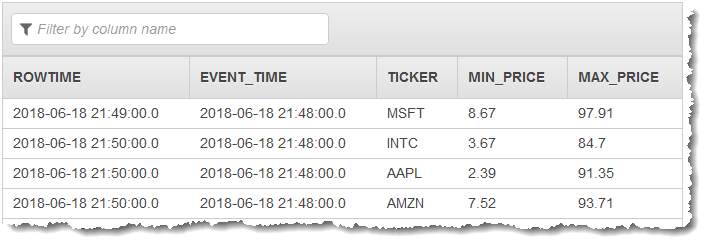After careful consideration, we have decided to discontinue Amazon Kinesis Data Analytics for SQL applications:
1. From September 1, 2025, we won't provide any bug fixes for Amazon Kinesis Data Analytics for SQL applications because we will have limited support for it, given the upcoming discontinuation.
2. From October 15, 2025, you will not be able to create new Kinesis Data Analytics for SQL applications.
3. We will delete your applications starting January 27, 2026. You will not be able to start or operate your Amazon Kinesis Data Analytics for SQL applications. Support will no longer be available for Amazon Kinesis Data Analytics for SQL from that time. For more information, see Amazon Kinesis Data Analytics for SQL Applications discontinuation.
Example: Tumbling Window Using an Event Timestamp
When a windowed query processes each window in a non-overlapping manner, the window is
referred to as a tumbling window. For details, see Tumbling Windows (Aggregations Using
GROUP BY). This
Amazon Kinesis Data Analytics example demonstrates a tumbling window that uses an event timestamp, which is
a user-created timestamp that is included in the streaming data. It uses this approach
rather than just using ROWTIME, which is a timestamp that Kinesis Data Analytics creates when the
application receives the record. You would use an event timestamp in the streaming data
if you want to create an aggregation based on when an event occurred, rather than when
it was received by the application. In this example, the ROWTIME value
triggers the aggregation every minute, and the records are aggregated by both
ROWTIME and the included event time.
In this example, you write the following records to an Amazon Kinesis stream. The
EVENT_TIME value is set to 5 seconds in the past, to simulate
processing and transmission lag that might create a delay from when the event occurred,
to when the record is ingested into Kinesis Data Analytics.
{"EVENT_TIME": "2018-06-13T14:11:05.766191", "TICKER": "TBV", "PRICE": 43.65} {"EVENT_TIME": "2018-06-13T14:11:05.848967", "TICKER": "AMZN", "PRICE": 35.61} {"EVENT_TIME": "2018-06-13T14:11:05.931871", "TICKER": "MSFT", "PRICE": 73.48} {"EVENT_TIME": "2018-06-13T14:11:06.014845", "TICKER": "AMZN", "PRICE": 18.64} ...
You then create a Kinesis Data Analytics application in the Amazon Web Services Management Console, with the Kinesis data stream as the
streaming source. The discovery process reads sample records on the streaming source and
infers an in-application schema with three columns (EVENT_TIME,
TICKER, and PRICE) as shown following.

You use the application code with the MIN and MAX functions
to create a windowed aggregation of the data. Then you insert the resulting data into
another in-application stream, as shown in the following screenshot:

In the following procedure, you create a Kinesis Data Analytics application that aggregates values in the input stream in a tumbling window based on an event time.
Step 1: Create a Kinesis Data Stream
Create an Amazon Kinesis data stream and populate the records as follows:
Sign in to the Amazon Web Services Management Console and open the Kinesis console at https://console.amazonaws.cn/kinesis
. -
Choose Data Streams in the navigation pane.
-
Choose Create Kinesis stream, and then create a stream with one shard. For more information, see Create a Stream in the Amazon Kinesis Data Streams Developer Guide.
-
To write records to a Kinesis data stream in a production environment, we recommend using either the Kinesis Client Library or Kinesis Data Streams API. For simplicity, this example uses the following Python script to generate records. Run the code to populate the sample ticker records. This simple code continuously writes a random ticker record to the stream. Keep the script running so that you can generate the application schema in a later step.
import datetime import json import random import boto3 STREAM_NAME = "ExampleInputStream" def get_data(): return { "EVENT_TIME": datetime.datetime.now().isoformat(), "TICKER": random.choice(["AAPL", "AMZN", "MSFT", "INTC", "TBV"]), "PRICE": round(random.random() * 100, 2), } def generate(stream_name, kinesis_client): while True: data = get_data() print(data) kinesis_client.put_record( StreamName=stream_name, Data=json.dumps(data), PartitionKey="partitionkey" ) if __name__ == "__main__": generate(STREAM_NAME, boto3.client("kinesis"))
Step 2: Create the Kinesis Data Analytics Application
Create a Kinesis Data Analytics application as follows:
Open the Managed Service for Apache Flink console at https://console.amazonaws.cn/kinesisanalytics
. -
Choose Create application, enter an application name, and choose Create application.
-
On the application details page, choose Connect streaming data to connect to the source.
-
On the Connect to source page, do the following:
-
Choose the stream that you created in the preceding section.
-
Choose Discover Schema. Wait for the console to show the inferred schema and samples records that are used to infer the schema for the in-application stream created. The inferred schema has three columns.
-
Choose Edit Schema. Change the Column type of the EVENT_TIME column to
TIMESTAMP. -
Choose Save schema and update stream samples. After the console saves the schema, choose Exit.
-
Choose Save and continue.
-
-
On the application details page, choose Go to SQL editor. To start the application, choose Yes, start application in the dialog box that appears.
-
In the SQL editor, write the application code, and verify the results as follows:
-
Copy the following application code and paste it into the editor.
CREATE OR REPLACE STREAM "DESTINATION_SQL_STREAM" (EVENT_TIME timestamp, TICKER VARCHAR(4), min_price REAL, max_price REAL); CREATE OR REPLACE PUMP "STREAM_PUMP" AS INSERT INTO "DESTINATION_SQL_STREAM" SELECT STREAM STEP("SOURCE_SQL_STREAM_001".EVENT_TIME BY INTERVAL '60' SECOND), TICKER, MIN(PRICE) AS MIN_PRICE, MAX(PRICE) AS MAX_PRICE FROM "SOURCE_SQL_STREAM_001" GROUP BY TICKER, STEP("SOURCE_SQL_STREAM_001".ROWTIME BY INTERVAL '60' SECOND), STEP("SOURCE_SQL_STREAM_001".EVENT_TIME BY INTERVAL '60' SECOND); -
Choose Save and run SQL.
On the Real-time analytics tab, you can see all the in-application streams that the application created and verify the data.
-